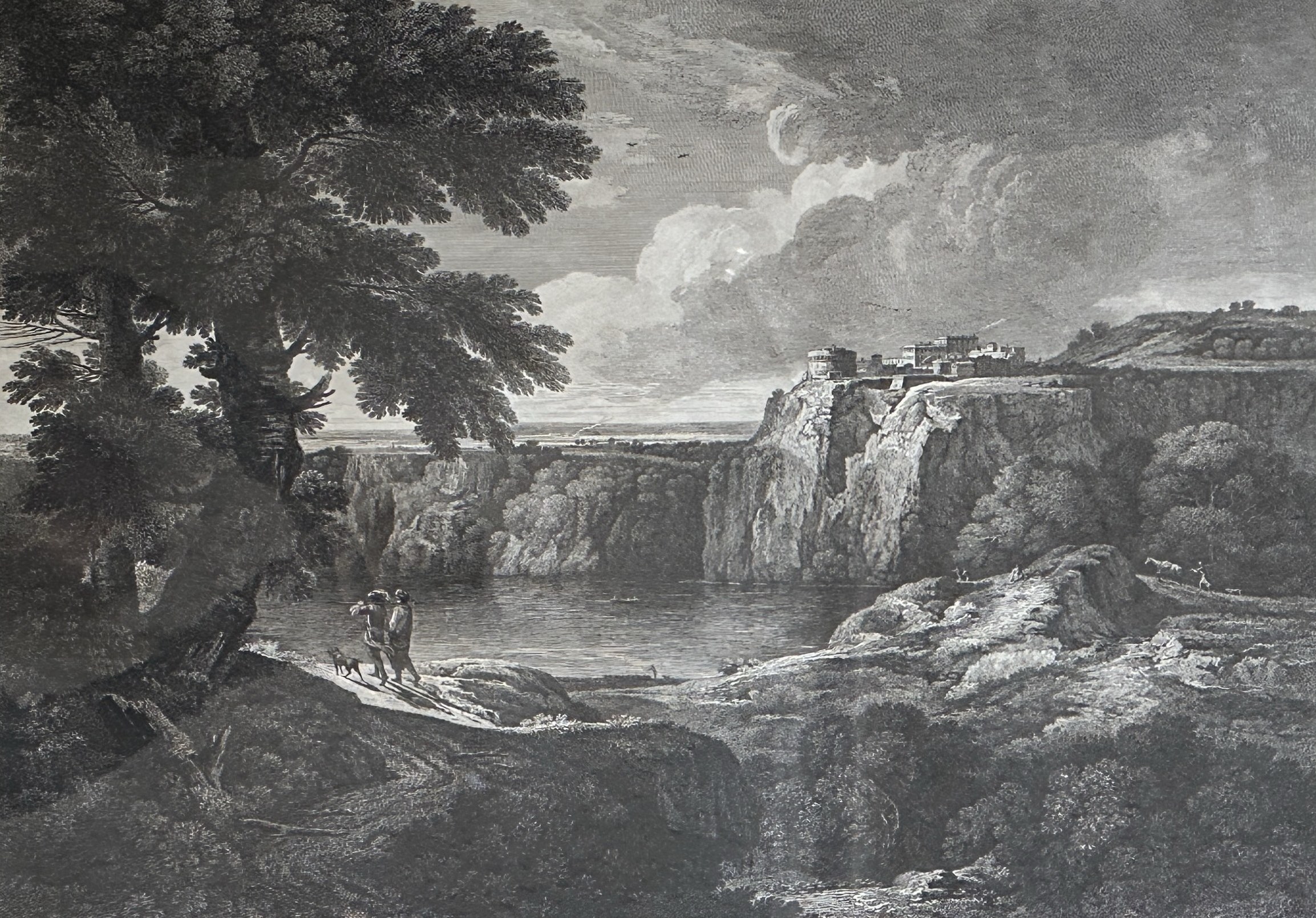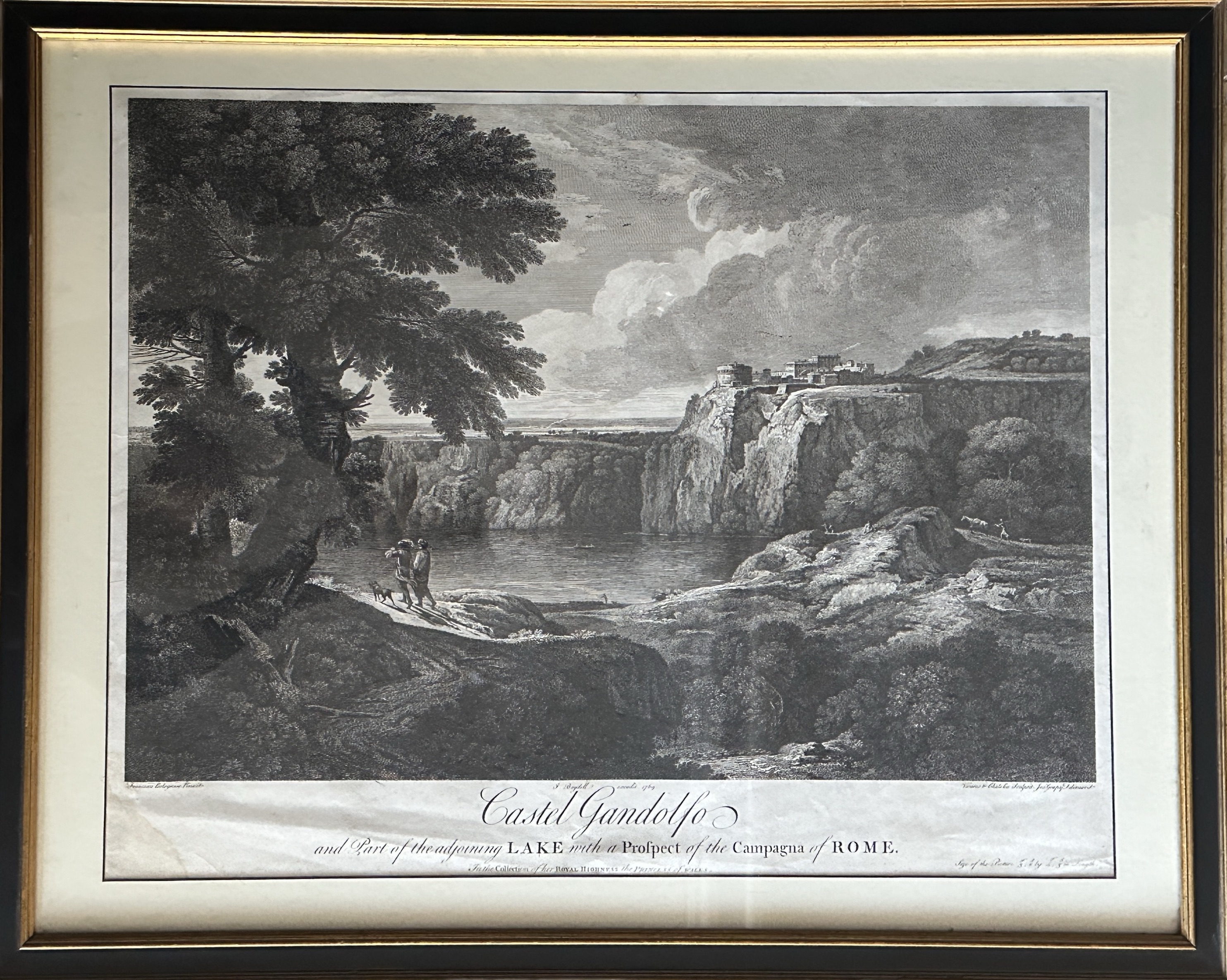Castel Gandolfo and Part of the adjoining Lake with a Prospect of the Campagna of Rome
Jean Baptiste-Claude Chatelain
Castel Gandolfo and Part of the adjoining Lake with a Prospect of the Campagna of Rome
Artist:
Jean Baptiste-Claude Chatelain
Medium: Prints
Price:
$400.00
Gallery:
Second Story Art
Add to Favorites
Details
Creation Date: 1769
Materials: ink on paper
Dimensions: 24" x 30" x 1"
Condition: Very Good. 3” x 2” stain in lower left margin, not affecting image.
Finish: Framed
About the Item
Jean-Baptiste-Claude Chatelain 1769 engraving titled “Castel Gandolfo and Part of the adjoining Lake with a Prospect of the Campagna of Rome” after a painting by Giovanni Francesco Grimaldi (Italian, 1606–1680). Published by John Boydell (Shropshire 1720–1804 London). Another print from this engraving is in the permanent collections of the Metropolitan Museum of Art, The British Museum and Harvard Art Museum. Image measures 14.5 in x 23.5 in. Frame measures 24 in x 30 in. Not examined out of frame. Two other Chatelain engravings currently for sale on Arts and Object Marketplace.
Chatelain, whose name is often spelled “Chatelin” under engravings, was employed by publisher John Boydell in London, and with François Vivares produced a number of landscape engravings after works by masters such as Rembrandt. To boost sales, Boydell often capitalized on Vivares’ popularity and credited him on plates engraved by Chatelain alone. The French engraver François Vivares (1709–1780) set up shop in London at the age of 18. François Vivares engraved some 160 plates, most of which were published by John Boydell. The intermediary draftsman Joseph Goupy (French, ca. 1700–1782) also collaborated on this and the other two Chatelain engravings currently for sale on Arts and Object Marketplace.
John Boydell (1720 – 1804) was an English publisher noted for his reproductions of engravings. He helped alter the trade imbalance between Britain and France in engravings and initiated an English tradition in the art form. A former engraver himself, Boydell promoted the interests of artists as well as patrons and as a result his business prospered.
Boydell apprenticed himself to William Henry Toms, an artist he admired, and learned engraving. He established his own business in 1746 and published his first book of engravings around the same time. Boydell did not think much of his own artistic efforts and eventually started buying the works of others, becoming a print dealer as well as an artist. He became a successful importer of French prints during the 1750s but was frustrated by their refusal to trade prints in kind. To spark reciprocal trade, he commissioned William Wollett's spectacular engraving of Richard Wilson's The Destruction of the Children of Niobe, which revolutionized the print trade. Ten years later, largely as a result of Boydell's initiative, the trade imbalance had shifted, and he was named a fellow of the Royal Society for his efforts.
In the 1790s, Boydell began a large Shakespeare venture that included the establishment of a Shakespeare Gallery, the publication of an illustrated edition of Shakespeare's plays, and the release of a folio of prints depicting scenes from Shakespeare's works. Some of the most illustrious painters of the day contributed, such as Benjamin West and Henry Fuseli.
Four Boydell engravings of Shakespeare plays are currently for sale on Art and Object Marketplace. The two-volume Boydell Shakespeare folio set is currently available for sale on Second Story Books’ website.
Throughout his life, Boydell dedicated time to civic projects: he donated art to government institutions and ran for public office. In 1790 he became Lord Mayor of London. The French Revolutionary Wars led to a cessation in Continental trade at the end of the 1790s. Without this business, Boydell's firm declined and he was almost bankrupt at his death in 1804.
Chatelain, whose name is often spelled “Chatelin” under engravings, was employed by publisher John Boydell in London, and with François Vivares produced a number of landscape engravings after works by masters such as Rembrandt. To boost sales, Boydell often capitalized on Vivares’ popularity and credited him on plates engraved by Chatelain alone. The French engraver François Vivares (1709–1780) set up shop in London at the age of 18. François Vivares engraved some 160 plates, most of which were published by John Boydell. The intermediary draftsman Joseph Goupy (French, ca. 1700–1782) also collaborated on this and the other two Chatelain engravings currently for sale on Arts and Object Marketplace.
John Boydell (1720 – 1804) was an English publisher noted for his reproductions of engravings. He helped alter the trade imbalance between Britain and France in engravings and initiated an English tradition in the art form. A former engraver himself, Boydell promoted the interests of artists as well as patrons and as a result his business prospered.
Boydell apprenticed himself to William Henry Toms, an artist he admired, and learned engraving. He established his own business in 1746 and published his first book of engravings around the same time. Boydell did not think much of his own artistic efforts and eventually started buying the works of others, becoming a print dealer as well as an artist. He became a successful importer of French prints during the 1750s but was frustrated by their refusal to trade prints in kind. To spark reciprocal trade, he commissioned William Wollett's spectacular engraving of Richard Wilson's The Destruction of the Children of Niobe, which revolutionized the print trade. Ten years later, largely as a result of Boydell's initiative, the trade imbalance had shifted, and he was named a fellow of the Royal Society for his efforts.
In the 1790s, Boydell began a large Shakespeare venture that included the establishment of a Shakespeare Gallery, the publication of an illustrated edition of Shakespeare's plays, and the release of a folio of prints depicting scenes from Shakespeare's works. Some of the most illustrious painters of the day contributed, such as Benjamin West and Henry Fuseli.
Four Boydell engravings of Shakespeare plays are currently for sale on Art and Object Marketplace. The two-volume Boydell Shakespeare folio set is currently available for sale on Second Story Books’ website.
Throughout his life, Boydell dedicated time to civic projects: he donated art to government institutions and ran for public office. In 1790 he became Lord Mayor of London. The French Revolutionary Wars led to a cessation in Continental trade at the end of the 1790s. Without this business, Boydell's firm declined and he was almost bankrupt at his death in 1804.
About the Artist
Jean Baptiste-Claude Chatelain
Chatelain, whose name is often spelled “Chatelin” under engravings, was employed by publisher John Boydell in London, and with François Vivares produced a number of landscape engravings after works by masters such as Rembrandt. To boost sales, Boydell often capitalized on Vivares’ popularity and credited him on plates engraved by Chatelain alone. The French engraver François Vivares (1709–1780) set up shop in London at the age of 18. François Vivares engraved some 160 plates, most of which were published by John Boydell.
About the Gallery
Second Story Art
Since purchased by Allan Stypeck in 1974, Second Story Books has grown from its small second floor location in northwest Washington, D.C., to become one of the largest used and rare bookstores in the world. During the pre-internet era of bookselling, Second Story Books had six locations from Alexandria to Baltimore, including the famous Georgetown Saville Bookstore location. With the growth of the internet, Second Story Books consolidated its brick-and-mortar presence into our two locations.
Similar Artworks
Similar Artists
More from this Seller







 Facebook
Facebook
 X
X
 Email
Email





![PORTRAIT OF A KABUKI ACTOR [Signed]](https://d19sv06ke5lbyb.cloudfront.net/worker/items/21830-portrait-of-a-kabuki-actor-signed.jpg?format=auto&width=159&height=200)









![[QING DYNASTY PORTRAIT ALBUM]](https://d19sv06ke5lbyb.cloudfront.net/items/786-1701116531_d7ae56d31b0b6ab247d4.jpeg?format=auto&width=265&height=200)




